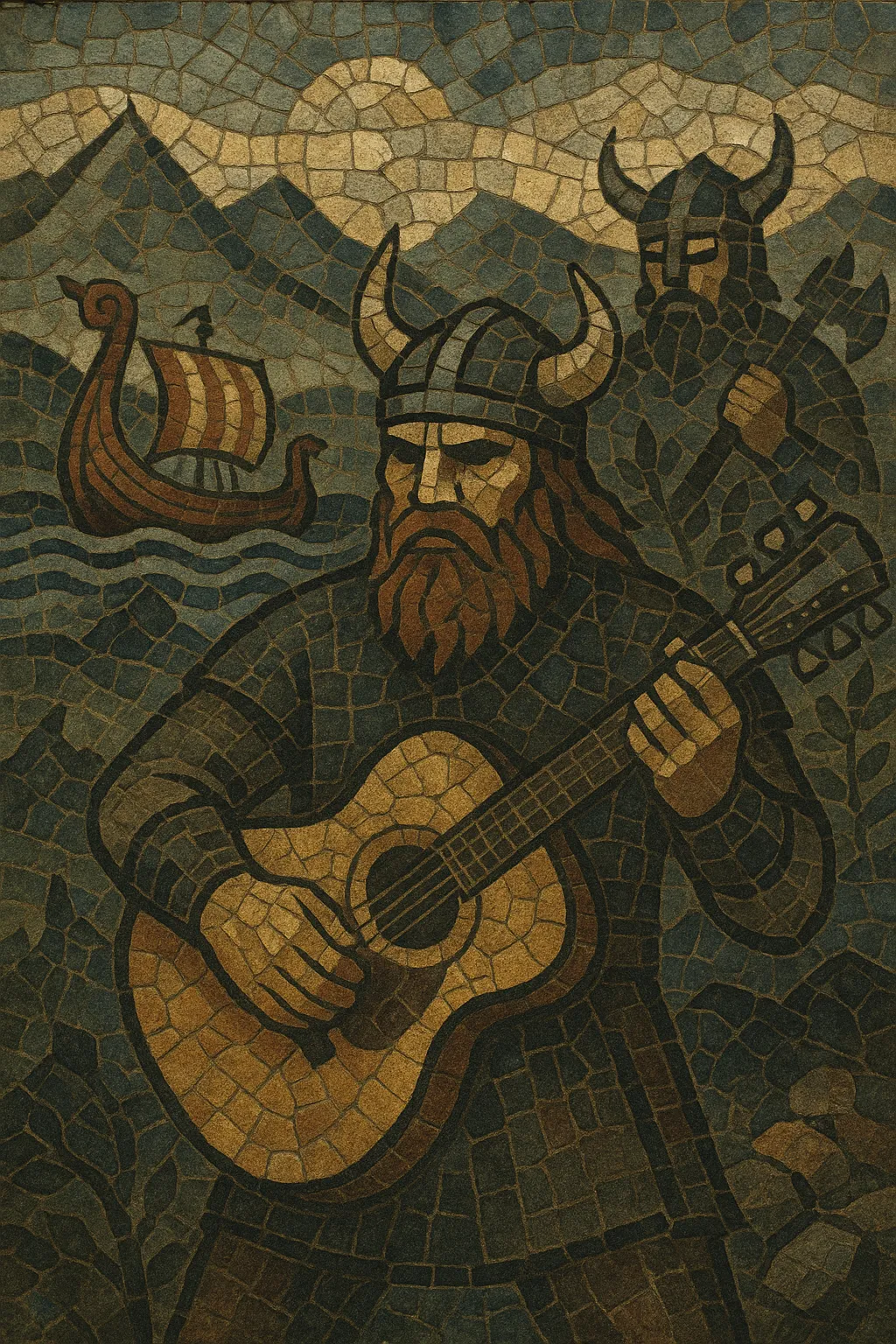Viking rock (Swedish: vikingarock) is a Swedish style of rock that fuses punk/Oi!-driven energy and classic rock songcraft with melodies, modes, and instruments drawn from Nordic and especially Swedish folk traditions.
Lyrics are typically in Swedish and focus on Norse history and myth, seafaring, landscapes, comradeship, and rural romanticism. Arrangements often feature anthemic choruses, gang vocals, and a steady, marching backbeat, while occasional use of folk instruments (such as flutes, bagpipes, fiddles, accordion, or mandola) colors the otherwise electric rock palette.
The style gained visibility in the early 1990s through bands that emphasized cultural-historical themes; some acts were also associated—controversially—with nationalist milieus. Musically, however, the core aesthetic remains a robust blend of rousing rock rhythm, pentatonic and Dorian folk inflections, and communal, sing‑along refrains.
The seeds of viking rock were sown in Sweden’s late‑1980s punk and Oi! scenes, where bands began to mix sturdy, sing‑along street‑rock with traditional Swedish and Nordic folk melodies and topics from Norse history and myth. This overlap reflected a broader Scandinavian interest in heritage‑oriented culture and a long native folk-music tradition that lent distinctive modes and rhythms to otherwise straightforward rock.
The genre’s identity coalesced in the early 1990s as Swedish groups codified its sound: mid‑tempo 4/4 beats; riff‑based guitar work; modal, folk‑tinged melodies (often Dorian/Aeolian); and rousing, chanted choruses. The use of Swedish lyrics and references to Viking‑age history and iconography helped distinguish it from international punk and classic rock. Media attention and commercial traction followed, with records entering Swedish charts and the term "vikingarock" becoming widely recognized.
While many songs focus on maritime lore, nature, and camaraderie, the scene also drew scrutiny due to overlapping circles with nationalist and identity‑political currents in parts of the 1990s rock underground. These associations were not universal across all artists, but they influenced public perception of the genre. Musically, however, its hallmarks remained consistent: anthem‑friendly hooks, gang vocals, and melodies shaped by Swedish/Nordic folk idioms.
Into the 2000s and beyond, viking rock maintained a niche audience in Sweden and among Scandinavian‑culture enthusiasts abroad. Some acts integrated more overt folk instrumentation and cleaner production, while others stayed close to a rawer Oi!/punk edge. The genre is distinct from (though thematically adjacent to) Viking metal: viking rock centers on rock/punk frameworks and sing‑along folk melodies rather than the extreme‑metal sonics of its metal counterpart.
Start with a classic rock setup: electric guitar(s), bass, and drums. Add folk colors where suitable—fiddle/nyckelharpa, tin whistle/recorder, bagpipes, accordion, acoustic guitar, or mandola. Keep guitars bright and riff‑forward, with open‑string drones that suggest folk modes.
Anchor songs in steady 4/4 at mid‑tempo (roughly 90–120 BPM). Emphasize a march‑like pulse with clear kick/snare accents and simple tom fills. For variety, intersperse half‑time choruses or a brisk two‑step feel; occasional 6/8 sections can evoke a seafaring sway.
Favor modal folk colors—Dorian and Aeolian work well—alongside pentatonic hooks. Common progressions include i–VII–VI (minor), I–bVII–IV (major), and i–VI–VII. Layer lead guitar or whistle over power‑chord frameworks with short, chantable motifs. Double main lines with octave or fifth harmonies to enhance the anthemic quality.
Use Swedish (or another Scandinavian language) for authenticity. Write about Norse myth (without needing to be literal), maritime life, historical episodes, nature, comradeship, and local lore. Craft big, call‑and‑response choruses and gang vocals; keep verses plain‑spoken and rhythmic so crowds can sing along. Avoid proselytizing or exclusionary themes—focus on storytelling and cultural‑historical imagery.
A straightforward verse–chorus–verse–chorus–bridge–chorus format suits the style. Introduce folk instruments in intros, breaks, or counter‑melodies. Use dynamic lifts into choruses (drum fills, cymbal swells, octave‑up vocal doubles). End with a final, extended sing‑along refrain.
Keep guitars crisp with moderate gain; let vocals sit upfront and intelligible. Pan folk instruments for width and use subtle room or plate reverbs for a communal hall feel. Master for punch and clarity rather than heavy saturation to preserve the marching drive.


